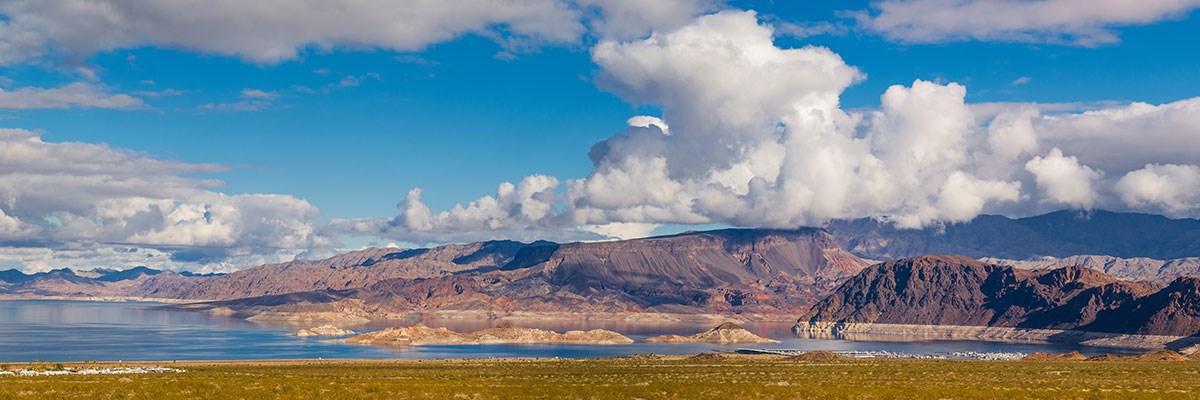
NPS Photo - Andrew Cattoir Mead is a large reservoir on the main stem of the Colorado River. Hoover Dam, which formed Lake Mead, is located in Black Canyon approximately 30 miles east of Las Vegas, NV in the Mojave Desert, Arizona-Nevada (Figure 1). At full pool, Lake Mead is the largest reservoir in the United States by volume and is second only to Lake Powell in surface area (Paulson and Baker 1983). Lake Mead has enough capacity to hold the entire average annual flow of the Colorado River for two years (WPRS 1981). At full pool, Lake Mead extends 65 miles from Hoover Dam to Pearce Ferry. Its greatest width is 9.3 miles, and the highly irregular shoreline is 550 miles in length (WPRS 1981).
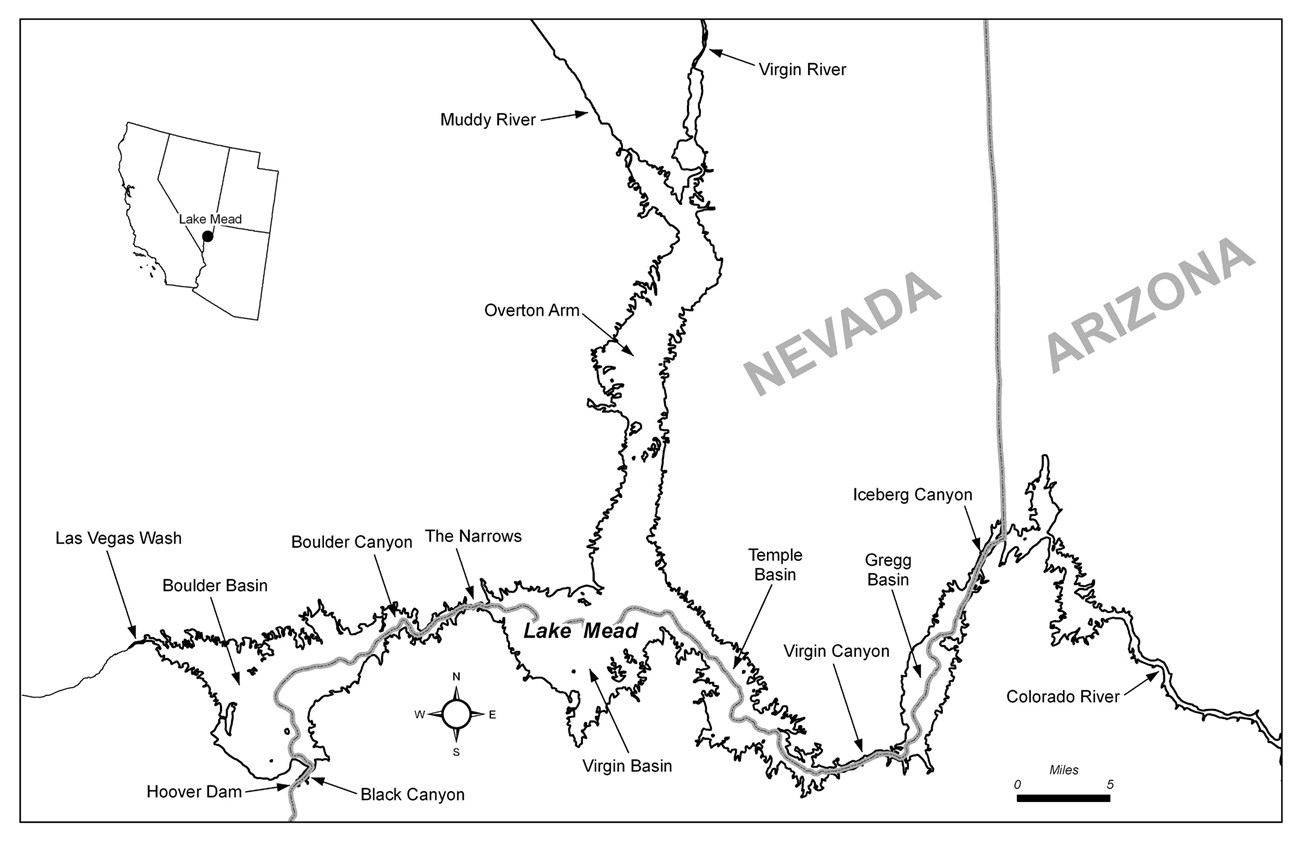
The construction of Hoover Dam was authorized by the Boulder Canyon Project Act in 1928 (Billington et al. 2005). The site for the dam was initially proposed to be within The Narrows at the upper end of Boulder Canyon (Figure 1), but it was recognized early in the planning process that a site in Black Canyon would be less costly, had a better geological setting and would also lead to additional water storage and hydropower generation. Construction of Hoover Dam started in 1931 and the dam started impounding water on 1 February 1935 (R. Walsh, U.S. Bureau of Reclamation, Nov. 2010, pers. comm.) Final construction work on the dam was completed in 1936 (Lara and Sanders 1970). Hoover Dam was one of the first multipurpose dams built by the federal government. Its primary intended uses were flood control, navigation, and generation of electrical energy. Other uses were facilitation of agricultural development in the Colorado Basin and Imperial Valley and municipal growth in Los Angeles (Billington et al. 2005). Hydropower generation was a key factor in financing the Boulder Canyon Project. The planned generating capacity of more than one million horsepower represented over 20 percent of the power generation capacity in the western states at the time of its construction. The first commercial power was generated at Hoover Dam on 7 October 1936, and continuous, commercial power generation began in June 1937 (Billington et al. 2005). The current rated capacity of the Hoover Dam power plant is 2,998,000 horsepower (USDOI). Income from power generation paid for construction of the dam and continues to pay for the operation, maintenance, and replacement work at the dam. Lake Mead currently provides municipal water for the cities of Las Vegas, Henderson, North Las Vegas, and Boulder City, NV, as well as municipal and industrial water and irrigation water for downstream users. Altogether, about 25,000,000 people rely on water from Lake Mead, and it is unlikely that the Southwest could have developed as it has without it. 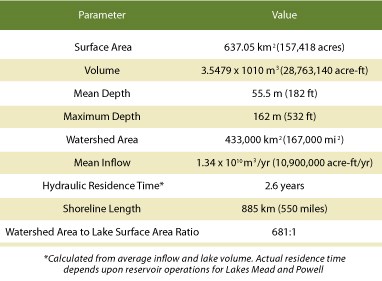
Lake Mead CharacteristicsThere is considerable confusion concerning some key morphometric and hydrologic characteristics of Lake Mead. Project data reported by the Bureau of Reclamation (WPRS 1981) includes volumes and surface areas for water surface elevations of 1,232 ft (crest of dam), 1,229 ft (top of flood control), and 1,221.4 ft (top of spillway gates). Lake surface areas, volumes, and maximum depths have been reported based on the original construction survey in 1935 before the dam was completed, a survey undertaken in 1948-49 to determine volume losses by sedimentation (U.S. DOI 1954, USGS 1960), and a 1963-64 survey to update the capacity of the reservoir at the time of the closure of Glen Canyon Dam in March 1963 (Lara and Sanders 1970). Lake Mead was surveyed again from 1999-2001 by the United States Geological Survey (USGS) and the Bureau of Reclamation; results from those surveys were reported by Twichell et al. (2003) and Ferrari (2008). Data from the 1999-2001 surveys are still undergoing verification, quality checking and quality assurance and will not replace data from the Lara and Sanders (1970) survey for operational purposes until that process is completed.Key characteristics of Lake Mead are summarized in Table 1. These data are based on data from Ferrari (2008) at the surface elevation of 1,221.4 ft. The mean inflow used was that reported by Ferrari (2008) for the period 1935-2001. 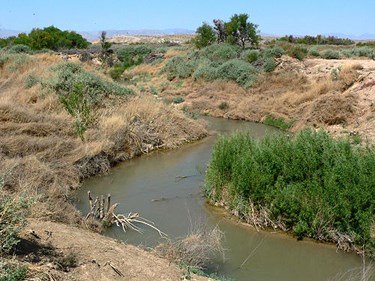
Sediment AccumulationSediment accumulation has been significant. Lara and Sanders (1970) reported that 1,425,900 acre-ft of sediment accumulated in Lake Mead between 1935 and 1948-49. An additional 1,293,100 acre-ft accumulated between 1948-49 and 1963-64, for a total of 2,716,900 acre-ft, or approximately 12% of the original lake volume. The completion of Glen Canyon Dam greatly slowed the amount of sediment transport to Lake Mead and was estimated to increase the life of Lake Mead by 500 years (Lara and Sanders 1970). The Ferrari (2008) survey confirmed the interception of most sediment by Lake Powell and found the volume of Lake Mead actually increased by 219,150 acre-ft between 1963-64 and 2001. The increase was attributed to the reduction in sediment inflow and the consolidation of previous sediment deposits.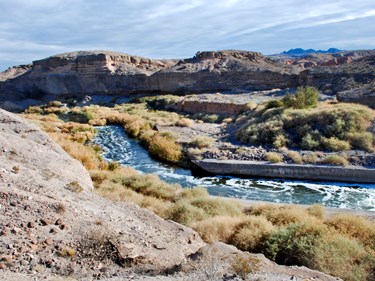
HydrologyLake Mead is fed by the Colorado River and three smaller tributaries: the Virgin and Muddy Rivers and Las Vegas Wash. Gregg Basin and Temple Basin are fed by the mainstream of the Colorado River, which now enters Lake Mead at the northern end of the Gregg Basin, nearly 60 miles upstream of Hoover Dam. The Virgin and Muddy Rivers flow into the Overton Arm, and then travel 25 miles under current conditions to merge with Colorado River water in the Virgin Basin. The combined flows from the upper end of the lake enter the east end of Boulder Basin at the Narrows. Las Vegas Wash enters Las Vegas Bay at the west end of Boulder Basin.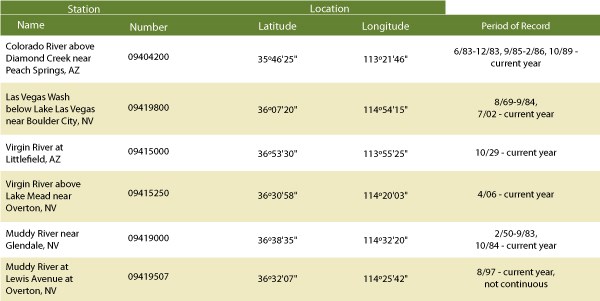
RunoffRunoff into Lake Mead can be estimated from USGS gaging stations on these tributaries (Table 2), but several factors affect the accuracy of those measurements. Surface runoff from the Lake Mead watershed was estimated from USGS water resources data for each of the four major tributaries to Lake Mead. Beginning with water year 2004, runoff data for these sites are only available on theInternet at https://waterdata.usgs.gov/nwis. Information on all gaging stations used to evaluate runoff is shown in Table 2.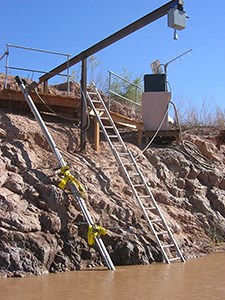
Gaging StationsStation 09404200, Colorado River above Diamond Creek near Peach Springs, AZ, is located near the lower end of the Grand Canyon 130 miles upstream from Hoover Dam; both water gains and water losses are expected as the Colorado River flows through the Grand Canyon, but no significant tributaries enter the Colorado River below Diamond Creek so this station should still provide a reasonably good estimate of inflow to Lake Mead. Available and estimated flow data since July 2002, when the Las Vegas Wash station resumed operation, indicate the Colorado River is currently contributing about 96.9% of the flow to Lake Mead. The Virgin River at Littlefield, AZ (09415000) and Muddy River near Glendale (09419000) stations have historically been used to describe inflows to Lake Mead because of their long periods of record. Station 09415000 is located 58 36 miles upstream of Lake Mead and Station 09419000 is located 16 miles upstream of the lake. Both of the stations significantly overestimate inflow to Lake Mead because agricultural operations between the gages and the lake divert almost the entire flow of both rivers during the summer months. As a result, many previous reports attribute too much flow to these two tributaries. Two lower stations, 09415250, Virgin River above Lake Mead near Overton, NV, and 09419507, Muddy River at Lewis Avenue at Overton, NV, were installed more recently and are located 4.2 and 5.75 miles, respectively, upstream of Lake Mead to give a much better indication of actual inflows. These stations have only operated for short periods and records are not continuous, but flow data clearly show the impacts of the diversions. Flows at the downstream Overton, NV, station on the Virgin River averaged 67% of the upstream Littlefield site (range = 0-129%) and the downstream Lewis Avenue site on the Muddy River averaged 40% of the upstream Glendale site (range = 17-53%). Due to falling water levels, the Virgin and Muddy Rivers have been entering Lake Mead as a combined inflow since July 2009. 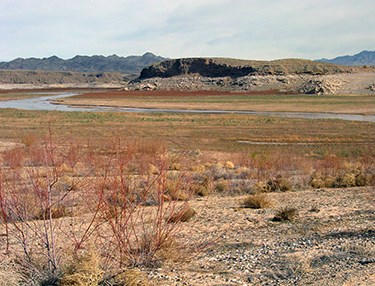
Annual InflowThe annual inflow via Las Vegas Wash has increased dramatically over the past 30 years as a result of the rapid population growth in Las Vegas. Flows from Las Vegas Wash into Lake Mead averaged over 287 cubic feet per second (cfs), or 2.2% of the total inflow, since 2002. This is more than double the average of 108 cfs measured at this station in the 1980s. Direct precipitation on the lake surface was calculated using data from the Western Regional Climate Center (http://www.wrcc.dri.edu/). Average precipitation from the period of record from five weather stations around Lake Mead (Callville Bay, NV, Station 261371; Echo Bay, NV, Station 262497; Valley of Fire State Park, NV, Station 268588; Temple Bar, AZ, Station 028516; Willow Beach, AZ, Station 029376) was 5.74 in/yr. At the full pool surface area of 2.10 x 109 m2, direct precipitation would contribute 75,500 acre-ft/yr, which is less than 1% of the total tributary inflow, but slightly more than inflow from the Virgin and Muddy Rivers.
Discharges through Hoover Dam are variable. Water is released as needed to meet water deliveries to Arizona, California, Nevada, and Mexico as stipulated by the Colorado River Compact. Most of Nevada's share of Colorado River water is withdrawn directly from Lake Mead to meet requirements for the Las Vegas Valley, but Nevada does have additional diversions downstream of Hoover Dam. Discharge from Hoover Dam occurs at elevations of 895 ft and 1,045 ft above mean sea level (msl). Both outlets are in the hypolimnion at full pool but the upper outlet is near the bottom of the epilimnion at current lake levels. The annual discharge is about 7.3 x 106 acre-ft. Annual withdrawals by the Southern Nevada Water Authority (SNWA) to provide municipal water for Las Vegas are currently about 450,000 acre-ft/yr (Roefer et al. 1996).
Evaporation in the area is extremely high and represents a significant water loss. Pan evaporation averages 113.53 in/yr in Boulder City, NV, corresponding to an evaporation rate of 79.5 in/yr from the lake surface (Farnsworth and Thompson 1982). At full pool, evaporative losses would be 1,045,000 acre-ft/yr, which is almost 10% of the average annual inflow.
In practice, the water budget for Lake Mead is highly regulated and depends primarily upon releases from Lake Powell through Glen Canyon Dam and downstream releases through Hoover Dam. River operations are controlled by the Bureau of Reclamation to meet legal requirements and contractual demands for municipal and industrial and irrigation water. The Bureau of Reclamation's operations use the RiverWare™ model to evaluate releases from Lake Powell to the Colorado River; consumption by the Southern Nevada Water Authority, downstream releases for the Central Arizona Project, Metropolitan Water District of Southern California, other Lower Basin water contractors; required deliveries under treaty with Mexico; inflows from other tributaries; bank storage; and evaporative losses to control inflows and outflows for Lake Mead. 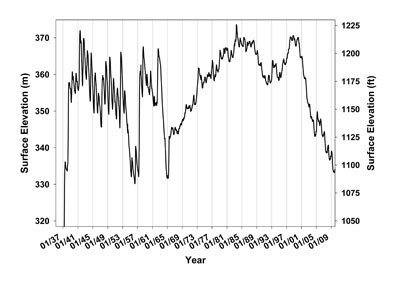
Lake ElevationLake surface elevation reflects the inflow-outflow regime, and large differences in elevation are primarily a reflection of drought years. Lake Mead began filling in late 1934 and the average daily surface elevations from 1 February 1935, when elevation data began to be collected, through 2009 are shown in Figure 2. The reservoir did not reach 1,045 ft above msl, the elevation of the upper outlet, until 1 May 1937. The reservoir filled to an elevation of greater than 1,200 ft above msl by mid-1941 and fluctuated annually between that elevation and 1,090 ft through the early 1960s. Glen Canyon Dam, which impounds Lake Powell, was completed in 1963 and Lake Powell began to fill. At the initial filling, Lake Mead elevations dropped significantly as inflows were reduced. Although Lake Mead gradually began filling again after Lake Powell reached the minimum pool required for power generation in that reservoir in 1965, full pool in Lake Mead was not reached again until 1983. Seasonal fluctuations due to variations in inflow were greatly reduced by the buffering capacity of Lake Powell (Figure 2). Lake Mead filled to capacity (elevation >1,221.4 ft) in July 1983 and the spillway gates operated for the first time under normal operating conditions. The maximum recorded elevation of 1,225.83 ft was reached on 24 July 1983. Lake Mead surface elevations dropped through the late 1980s and rose again to over 1,215 ft in 1999. Since that time, an extended drought and increasing water demands brought about by population growth in the Lake Mead watershed caused an unprecedented drop in lake levels. The impact of elevation on lake surface area is illustrated in Figure 3, which shows the change in surface area as the lake dropped from 1,148 ft to 1,100 ft, with elevation 1,099 ft reached in 2009. The surface area and lake volume at the 1,099 ft elevation are 89,814 acres and 142,844,400 acre-ft, respectively (Ferrari, 2008). These values are 57.0% of the area and 49.7% of the volume at full pool. Note that as of October 15, 2010, the surface elevation had further decreased to 1,083 ft. 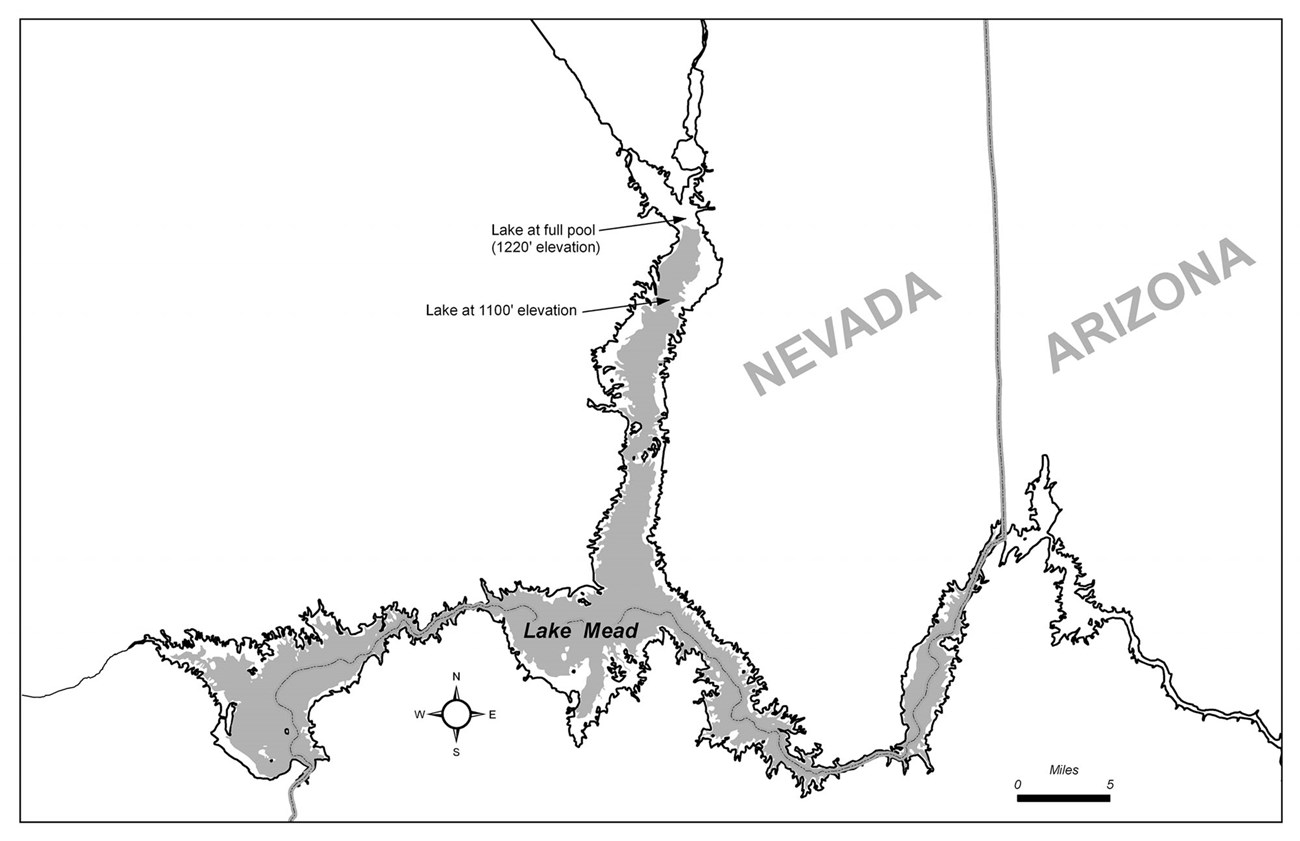
Water QualityBoulder Basin is the most intensively investigated area of Lake Mead because of its proximity to the Las Vegas drinking water intakes and the discharge at Hoover Dam. Representative studies of this area include Baker et al. (1977), LaBounty and Horn (1997), LaBounty and Burns (2005), and LaBounty (2008). Paulson and Baker (1983), and Holdren et al. (2006) presented results for the entire lake. As with many reservoirs, dam operations exert a great influence on the water quality and ecology of the system (Thornton 1990). The hydrodynamics of such large reservoirs are complex. Each basin within Lake Mead is ecologically unique, and therefore responds differently to the inflow-outflow regime. Furthermore, the different sources of water entering Lake Mead, as in other reservoirs (Ford 1990), often retain their identity and influence for substantial distances into the reservoir, and do not always mix completely with the rest of the water column. The incomplete mixing of inflows to Lake Mead with the surrounding water can lead to erroneous conclusions regarding the conveyance and fate of materials transported into the reservoir. 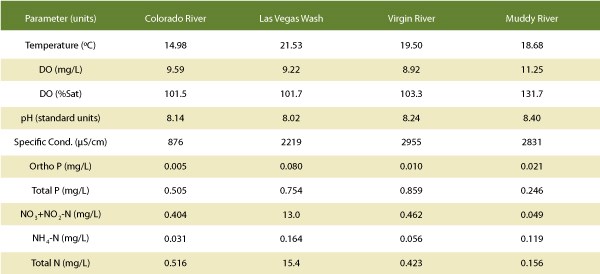
Lake Mead is a deep, subtropical monomictic lake (Baker et al. 1977). Stratification usually begins in May or June and turnover begins in November. Destratification is most complete in January or February, although Lake Mead does not completely destratify every year (LaBounty and Burns 2005). A pronounced, negative heterograde oxygen profile develops throughout the lake with stratification, leading to oxygen depletion at the thermocline. The metalimnetic oxygen depletion is the result of community biological respiration (Baker et al. 1977). 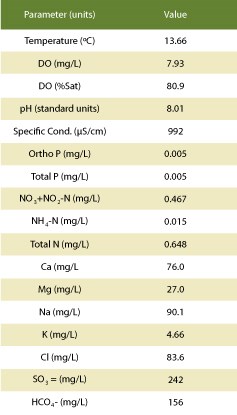
Productivity is usually low in the upper reaches of the lake because the Colorado, Virgin, and Muddy Rivers enter as underflows or interflows. On the basis of annual average total phosphorus concentrations (<0.006 mg/L), Secchi depths (>29.5 ft), and chlorophyll a concentrations (<0.001 mg/L) (TSC unpublished data), the Temple and Virgin Basins, the lower half of the Overton Arm, and the upper end of Boulder Basin would all be considered to be oligotrophic to mesotrophic according to the Carlson (1977) trophic state indices and EPA criteria (U.S. EPA 1980). In contrast, areas near the lake inlets typically have high nutrient concentrations (Table 3), high chlorophyll a concentrations (0.002 to >0.020 mg/L) and very low Secchi depths (usually <0.6 ft) and would be considered eutrophic to hypereutrophic. Note that phosphorus concentrations in Las Vegas Wash have been decreasing as a result of phosphorus removal efforts by wastewater dischargers. Lake Mead is strongly phosphorus limited (Paulson and Baker 1983, LaBounty and Burns 2005). The strongest statistical relationships with decreasing Secchi transparency are with chlorophyll a and total phosphorus concentrations (LaBounty 2008). Because of the discharge through Las Vegas Wash, a large fraction of Lake Mead's bioavailable nutrient loading is confined to the most downstream basin, Boulder Basin, and productivity is highest in that area of Lake Mead (Paulson and Baker 1983, Prentki and Paulson 1983, LaBounty and Horn 1997, LaBounty and Burns 2005). It is unusual for a reservoir to have its highest productivity in the most downstream basin and such a condition is opposite the more frequently observed decreasing productivity gradient from upstream to downstream (Kimmel et al. 1990). Water quality characteristics measured in the Lake Mead outflow (USGS Station 09421500, Colorado River below Hoover Dam, AZ-NV, https://waterdata.usgs.gov/) were used to approximate overall lake characteristics, although, as mentioned previously, characteristics of each individual basin are heavily influenced by their source inflows. Average values for physical characteristics, nutrients, and major ions from this station from 2001-2009 are summarized in Table 4. Biological Resources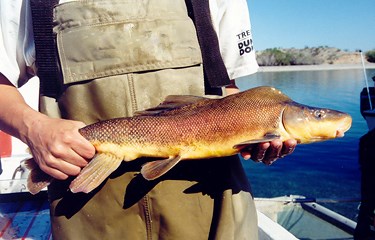
Native FishThe razorback sucker (Xyrauchen texanus) is the only native fish currently found in Lake Mead. This species is one of four endemic, large-river fish species of the Colorado River Basin presently considered endangered by the U.S. Department of the Interior (USFWS 1991). Razorback suckers were historically widespread and common throughout the larger rivers of the Colorado River Basin (Minckley et al. 1991), but the distribution and abundance of this species has been greatly reduced from historic levels. These declines have been attributed to human-caused alterations in the habitat, particularly the construction of dams and the resultant cool tailwaters and reservoir habitats that replaced the relatively warm, riverine environment (Holden and Stalnaker 1975, Joseph et al. 1977, Wick et al. 1982, Minckley et al. 1991) and the introduction of numerous species of non-native fish to these newly created habitats (Minckley et al. 1991, Marsh et al. 2003).It is unknown why razorback suckers have been able to persist in Lake Mead for the past 75 years without population augmentation, and why they are able to continue to recruit new adults into their population when there is no evidence that they have been able to do this anywhere else in the Colorado River System in recent years. The working hypothesis is that recruitment is taking place only in areas where high turbidity is providing adequate cover for young razorbacks to escape predators. There are essentially four areas that stand out in terms of these unique cover aspects conducive to razorback sucker recruitment, namely, the Las Vegas Wash inflow, the Muddy River/Virgin River inflow, Echo Bay, and the Colorado River inflow (Golden and Holden 2001, 2002, and 2003). Currently, it is known that recruiting populations occur at the Las Vegas Wash inflow, Echo Bay and the Muddy River/Virgin River inflow areas. Umek and Chandra (2010) provide additional information on razorback suckers in Lake Mead. Click to visit the Lake Mead National Recreation Area fish page. 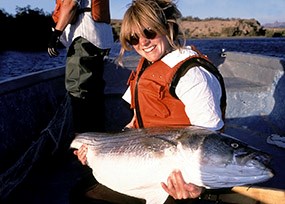
SportfishThe sport fishery in Lake Mead consists entirely of exotic game species which have been either stocked within the reservoir or which arrived from one of the tributaries. Principal game species, which have established self-sustaining populations, include striped bass (Morone saxatilis), largemouth black bass (Micropterus salmoides), smallmouth black bass (Micropterus dolomieu), black bullhead (Ameiurus melas), channel catfish (Ictalurus punctatus), crappie (Pomoxis spp.), green sunfish (Lepomis cyanellus), common carp (Cyprinus carpio), tilapia (Tilapia spp.), and bluegill (Lepomis macrochirus). The Nevada Division of Wildlife stocks rainbow trout (Oncorhynchus mykiss) during the winter to provide a "put-and-take" sport fishery.
Two forage fish are also found in Lake Mead and are important in maintaining the sport fishery. The threadfin shad (Dorosoma petenense) was first introduced into the lake in 1955. Gizzard shad (Dorosoma cepedianum), a less desirable forage species, was first detected in Lake Mead in 2007, and have apparently become well established. Lake Mead National Recreation Area fish page. 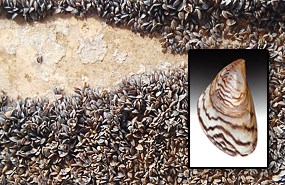
Biological Threat - Quagga MusselsAdult quagga mussels (Dreissena rostriformis bugensis) were found in Lake Mead in January 2007, with the initial colonization probably occurring 3-4 years earlier (Moore 2010). Veligers first appeared in TSC samples in March 2007 and had spread to all sampling stations by May 2008 (Holdren et al. 2010). Significant impacts on water quality, lake biology and infrastructure were expected based on experiences with zebra mussels (Dreissena polymorpha) in other parts of the country (LaBounty 2008, Beaver et al. 2010). To date, no significant impacts on either water quality or lake biota have been published that can be directly attributed to quagga mussels, but Beaver et al. (2010), Mueting et al. (2010) and Wittmann et al. (2010) discuss various aspects of quagga mussel biology in Lake Mead in this issue of Lake and Reservoir Management. Infrastructure impacts have been significant for both Reclamation's operations at Hoover Dam and SNWA's water intakes. Mussel colonization creates concerns for water delivery and has led to increased operational costs. Research on dealing with infrastructure impacts continues. Lake Mead National Recreation Area quagga mussel page. 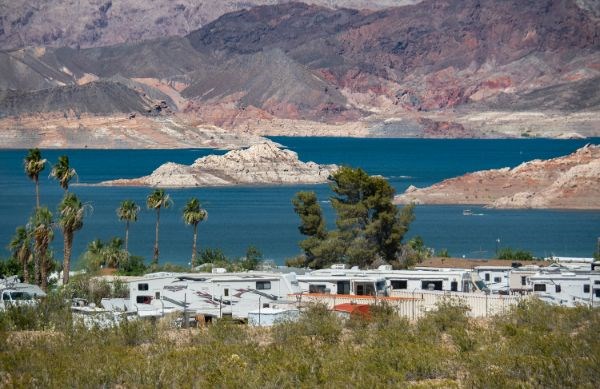
RecreationLake Mead National Recreation Area annually receives approximately eight million recreational visits with approximately 50 percent of visitors traveling from Southern California. The remaining visitors are primarily from Nevada, Arizona, Utah, and other western states. Currently, there are four marinas in operation on Lake Mead, through concession contracts with the NPS. There are six boat launch ramps on Lake Mead. When all facilities are operational at high water levels, the marina capacity for Lake Mead as established by the 2005 Lake Mead National Recreation Area Lake Management Plan is 3,357 slips and an additional 460 boats are available for rent from concessions. The daily public launch capacity was set at 3,000 boats and the boating capacity for Lake Mead was set at 3,295 boats on the water at any one time. 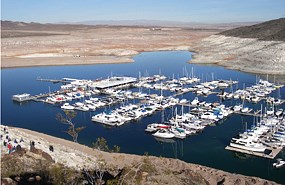
Declining Lake LevelsThe declining lake levels observed between 2000 and 2010 affected public access to Lake Mead and created infrastructure modification and operational demands on the NPS and its concessioners. At an elevation of 1,082 ft in October 2010, the lake is almost 140 ft below full pool elevation. Boat launch ramps at Pearce Ferry, Government Wash, Las Vegas Bay, and Overton Beach have been closed as lake waters have receded such that those ramps no longer provide reasonable access. Low water levels forced closure of marina operations at Las Vegas Bay, Boulder Harbor, and Overton Beach. All lake access points have been dramatically impacted. Concessioners are having difficulty moving the marinas and extending utilities to keep the marinas operational at current water levels, and water levels continue to drop. At each of the public launch ramps, the NPS and its concessioners continue to chase water depths compatible with boating recreation; falling lake levels adversely impact recreational lake access and, in turn, visitor use at Lake Mead. ConclusionsLake Mead is arguably the most important reservoir in the United States because of its size and user population. Managing this resource presents a variety of challenges because of its size and complexity. As a result of the importance of Lake Mead as a source of water, power, and recreation, it is critical that those challenges be met. Concern over the these management challenges led to the development of a long term monitoring and research plan (Turner et al. 2010) for Lake Mead and Lake Mohave.The NPS is managing this activity, but many other stakeholders are contributing to the process. The management plan is being used to categorize lake resources, guide research on lake chemistry and biology, evaluate potential impacts of the quagga mussel invasion, and serve as a road map for future management decisions. ReferencesBaker, JR, Deacon JE, Burke TA, Egdorf SS, Paulson LJ, Tew RW. 1977. Limnological Aspects of Lake Mead, Nevada-Arizona. US Department of the Interior, Bureau of Reclamation Report REC-ERC-77-9. Beaver JB, Tietjen TE, Blasius-Wert BJ, Kirsch JE, Rosati TC, Holdren GC, Kennedy EM, Hollis RM, Teacher CE, Buccier KM, Evans SK. 2010. Persistence of Daphnia in the epilimnion of Lake Mead, Arizona-Nevada, during extreme drought and expansion of invasive quagga mussels (2000-2009). Lake and Reserv. Manage. 26: (in review) Billington, DP, Jackson DC, Melosi MV. 2005. The History of Large Federal Dams: Planning, Design, and Construction. US Department of the Interior, Bureau of Reclamation; U.S. Army Corps of Engineers; US Department of the Interior, National Park Service. Carlson RE. 1977. A trophic state index for lakes. Limnology and Oceanography 22:361-369 Farnsworth RE, Thompson ES. 1982. Mean monthly, seasonal, and annual pan evaporation for the United States. Office of Hydrology, National Weather Service, Washington, DC NOAA Technical Report NWS 34. Ferrari RL. 2008. 2001 Lake Mead sedimentation survey. Bureau of Reclamation, Technical service Center, Denver, CO. Available at: http://www.usbr.gov/pmts/sediment/projects/ReservoirSurveys/index.html. Accessed 28 October 2010. Ford DE. 1990. Reservoir transport processes. In: Thornton KW, Kimmel BL Payne FE, editors. Reservoir Limnology: Ecological Perspectives, John Wiley and Sons, New York. p. 15-42. Golden ME, Holden PB. 2001. Comparison of water quality, zooplankton density, and cover in razorback sucker (Xyrauchen texanus [Abbott]) spawning Areas of Lake Mead and Lake Mojave. BIO-WEST Inc., Logan, UT. PR-749-2. Published Report-664433. Golden ME, Holden PB. 2002. Comparison of water quality, zooplankton density, and cover in razorback sucker (Xyrauchen texanus [Abbott]) spawning areas of Lake Mead and Lake Mojave draft 2002 annual report. BIO-WEST Inc.. Logan, UT. PR-784-1. Published Report-664432. Golden ME, Holden PB. 2003. Determining conditions that promote razorback sucker recruitment in Lake Mead: a summary of the 2000-2002 pilot study. BIO-WEST Inc.. Logan, Utah. PR-784-2. Published Report-664434. Holden PB, Stalnaker CB. 1975. Distribution and abundance of mainstream fishes of the middle and upper Colorado River Basins, 1967-1973. Transactions of the American Fisheries Society 104 (2): 217-231. Holdren GC, Horn MJ, Lieberman DM. 2006. The limnology of Boulder Basin, Lake Mead, Arizona-Nevada, 2003 Report of Findings. US Department of the Interior, Bureau of Reclamation, Denver, CO Technical Memorandum 8220-06-11 Holdren GC, Hosler D, Wong D. 2010. Spread and abundance of quagga mussel veligers in Lake Mead, Nevada-Arizona, from 2007 to 2009. Presented at Aquaculture 2010, March 1-5, 2010, San Diego, CA. Joseph TW, Sinning JA, Behnke RJ, Holden PB. 1977. An evaluation of the status, life history, and habitat requirements of endangered and threatened fishes of the upper Colorado River system. US Fish and Wildlife Service, Fort Collins, CO FWS/OBS-77-62. Kimmel BL, OT Lind, LJ Paulson. 1990. Reservoir Primary Production. In: Thornton KW,Kimmel BL Payne FE, editors. Reservoir Limnology: Ecological Perspectives, John Wiley and Sons, New York. p. 133-194 LaBounty JF. 2008. Secchi Transparency of Boulder Basin, Lake Mead, Arizona-Nevada: 1990-2007. Lake Reserve. Manage. 24:207-218. LaBounty JF, Horn MJ. 1997. The influence of drainage from the Las Vegas Valley on the limnology of Boulder Basin, Lake Mead, Arizona-Nevada. Lake and Reserve. Manage. 13:95-108. LaBounty JF, Burns NM. 2005. Characterization of Boulder Basin, Lake Mead, Nevada-Arizona, USA - Based on analysis of 45 limnological Parameters. Lake and Reserv. Manage. 21:277-307. Lara, JM, Sanders JI. 1970. The 1963-64 Lake Mead study. US Department of the Interior, Bureau of Reclamation Report No. REC-OCE-70-21. Marsh PC, Pacey CA, Kesner BR. 2003. Decline of the razorback sucker in Lake Mojave, Colorado River, Arizona and Nevada. Transactions of the American Fisheries Society 132:1251–1256 Minckley WL, Marsh PC, Brooks JE, Johnson JE, Jensen BL. 1991. Management toward recovery of the razorback sucker. In: Minckley WL, Deacon JE, editors. Battle against extinction: native fish management in the American West. University of Arizona Press, Tucson. p. 303-357 Moore B. 2010. The first confirmed case of dreissenid mussels in the western United States: Discovery, distribution and growth of adult quagga mussels in Lakes Mead and Mohave. Presented at Aquaculture 2010, March 1-5, 2010, San Diego, CA. Mueting SA, Gerstenberger SL,Wong WH. 2010. An evaluation of artificial substrates for monitoring the quagga mussel (Dreissena bugensis) in Lake Mead, NV-AZ. Lake and Reserv. Manage. 26: (in review) [NPS] National Park Service. 2005. 2005 Lake Management Plan. Lake Mead National Recreation Area, National Park Service, Department of the Interior. Paulson, LJ, Baker JR. 1983 (revised 1984). The limnology in reservoirs on the Colorado River. Lake Mead Limnological Research Center, Department of Biological Sciences, University of Nevada, Las Vegas Technical Report No. 11. Prentki RT, Paulson LJ. 1983. Historical patterns of phytoplankton productivity in Lake Mead. In: Adams VD, Lamarra VA, editors Aquatic Resources Management of the Colorado River Ecosystem. Ann Arbor Science, Ann Arbor, Mich. p. 105-123. Roefer PA, Monscvitz JT, Rexing DJ. 1996. The Las Vegas cryptosporidiosis outbreak. Jour. Amer. Water Works Assoc. 88(9):95-106. Ryan R, Zhou X. 2010. TDS and selenium projections for the Las Vegas Wash, post completion of the Systems Conveyance and Operations Program (SCOP). Lake and Reserv. Manage. 26: (in review) Thornton KW. 1990. Perspectives on reservoir limnology. In: Thornton KW, Kimmel BL, Payne FE, editors. Reservoir Limnology: Ecological Perspectives, John Wiley and Sons, New York. p. 1-14. Turner K, Miller JM, Palmer CJ. 2010. Long-term limnological and aquatic resource monitoring and research plan for Lakes Mead and Mohave. Lake Mead National Recreation Area, National Park Service, Department of the Interior. Twichell, DC, Cross VA, Belew SD. 2003. Mapping the floor of Lake Mead (Nevada and Arizona): Preliminary discussion and GIS data release. USGS Open-File Report 03-320. Umek, Chandra S. 2010. Lake and Reserv. Manage. 26: (in review) [USDOI] United States Department of the Interior. 1954. Lake Mead Comprehensive Survey of 1948-1949, Volumes I, II, and III. [USDOI] United States Department of the Interior. Frequently Asked Questions and Answers. Department of the Interior, Bureau of Reclamation, Lower Colorado Region.http://www.usbr.gov/lc/hooverdam/faqs/faqs.html. Accessed 10 November 2010. [USEPA] United States Environmental Protection Agency. 1980. Clean lakes program guidance manual. Washington, D.C. EPA-440/5-81-003. [USFWS] United States Fish and Wildlife Service. 1991. Endangered and threatened wildlife and plants: the razorback sucker (Xyrauchen texanus) determined to be an endangered species. Federal Register 56:205(23 October 1991):54957–54967. [USGS] United States Geological Survey. 1960. Comprehensive survey of sedimentation in Lake Mead, 1948-1949. Professional Paper 295. [USGS] United States Geological Survey. National Water Information System. https://waterdata.usgs.gov/nwis. Accessed 10 November 2010. Wick EJ, McAda CW, Bulkley RV. 1982. Life history and prospects for recovery of the razorback sucker. In: Miller WH, Tyus HM, Carlson CA, editors. Fishes of the Upper Colorado River system: present and future. Western Division, American Fisheries Society, Bethesda, Maryland. p. 120-126
Wittmann, M 2010. Lake and Reserv. Manage. 26: (in review) [WPRS] United States Department of the Interior, Water and Power Resources Service. 1981. Project Data. Western Regional Climate Center. http://www.wrcc.dri.edu/. Accessed 28 Oct 2010. |
Last updated: December 13, 2022
